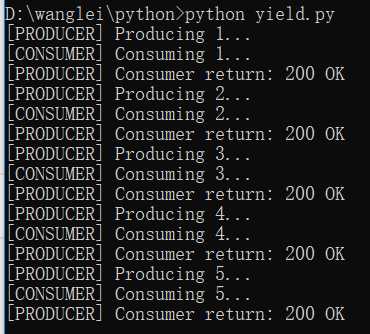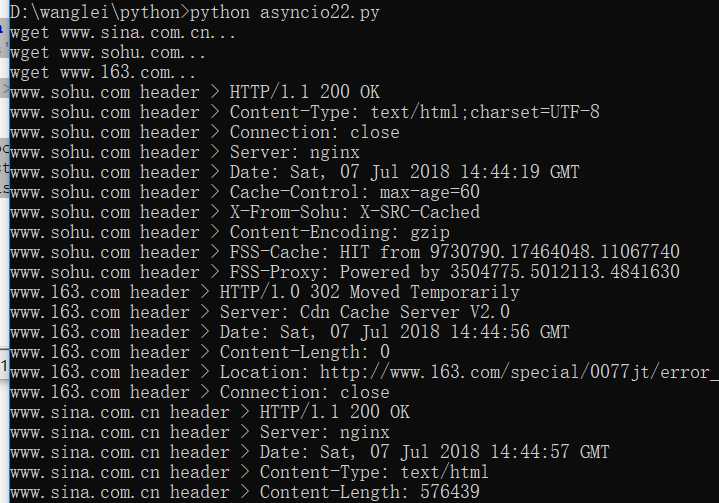标签:oop eve outer 方法 strip() current 多个 状态 router
No1:
协程看上去也是子程序,但执行过程中,在子程序内部可中断,然后转而执行别的子程序,在适当的时候再返回来接着执行。
优势:
1.最大的优势就是协程极高的执行效率。因为子程序切换不是线程切换,而是由程序自身控制,因此,没有线程切换的开销,和多线程比,线程数量越多,协程的性能优势就越明显。
2.不需要多线程的锁机制,因为只有一个线程,也不存在同时写变量冲突,在协程中控制共享资源不加锁,只需要判断状态就好了,所以执行效率比多线程高很多。
No2:
因为协程是一个线程执行,那怎么利用多核CPU呢?最简单的方法是多进程+协程,既充分利用多核,又充分发挥协程的高效率,可获得极高的性能。
Python对协程的支持是通过generator实现的。
def consumer(): r = ‘‘ while True: n = yield r if not n: return print(‘[CONSUMER] Consuming %s...‘ % n) r = ‘200 OK‘ def produce(c): c.send(None) n = 0 while n < 5: n = n + 1 print(‘[PRODUCER] Producing %s...‘ % n) r = c.send(n) print(‘[PRODUCER] Consumer return: %s‘ % r) c.close() c = consumer() produce(c)
运行结果

consumer函数是一个generator,把一个consumer传入produce后:
首先调用c.send(None)启动生成器;
然后,一旦生产了东西,通过c.send(n)切换到consumer执行;
consumer通过yield拿到消息,处理,又通过yield把结果传回;
produce拿到consumer处理的结果,继续生产下一条消息;
produce决定不生产了,通过c.close()关闭consumer,整个过程结束。
整个流程无锁,由一个线程执行,produce和consumer协作完成任务,所以称为“协程”,而非线程的抢占式多任务
No3:
【asyncio】
import asyncio async def hello(): print("Hello world!") r=await asyncio.sleep(1) print("Hello again!") loop=asyncio.get_event_loop() loop.run_until_complete(hello()) loop.close()
运行结果

import threading import asyncio @asyncio.coroutine def hello(): print(‘Hello world! (%s)‘ % threading.currentThread()) yield from asyncio.sleep(1) print(‘Hello again! (%s)‘ % threading.currentThread()) loop=asyncio.get_event_loop() tasks=[hello(),hello()] loop.run_until_complete(asyncio.wait(tasks)) loop.close()
运行结果

import asyncio @asyncio.coroutine def wget(host): print(‘wget %s...‘ % host) connect=asyncio.open_connection(host,80) reader,writer=yield from connect header=‘GET / HTTP/1.0\r\nHost:%s\r\n\r\n‘ % host writer.write(header.encode(‘utf-8‘)) yield from writer.drain() while True: line = yield from reader.readline() if line == b‘\r\n‘: break print(‘%s header > %s‘ % (host,line.decode(‘utf-8‘).rstrip())) writer.close() loop=asyncio.get_event_loop() tasks=[wget(host) for host in [‘www.sina.com.cn‘,‘www.sohu.com‘,‘www.163.com‘]] loop.run_until_complete(asyncio.wait(tasks)) loop.close()
运行结果

No4:
异步操作需要在coroutine中通过yield from完成;
多个coroutine可以封装成一组Task然后并发执行。
No5:
async和await是针对coroutine的新语法,要使用新的语法,只需要做两步简单的替换:
@asyncio.coroutine替换为async;yield from替换为await。No6:
【aiohttp】
import asyncio from aiohttp import web async def index(request): await asyncio.sleep(0.5) return web.Response(body=b‘<h1>Index</h1>‘, content_type=‘text/html‘) async def hello(request): await asyncio.sleep(0.5) text=‘<h1>hello,%s!</h1>‘ % request.match_info[‘name‘] return web.Response(body=text.encode(‘utf-8‘), content_type=‘text/html‘) async def init(loop): app=web.Application(loop=loop) app.router.add_route(‘GET‘,‘/‘,index) app.router.add_route(‘GET‘,‘/hello/{name}‘,hello) srv=await loop.create_server(app.make_handler(),‘127.0.0.1‘,8000) print(‘Server started at http://127.0.0.1:8000...‘) return srv loop=asyncio.get_event_loop() loop.run_until_complete(init(loop)) loop.run_forever()
运行结果


标签:oop eve outer 方法 strip() current 多个 状态 router
原文地址:https://www.cnblogs.com/anni-qianqian/p/9278286.html